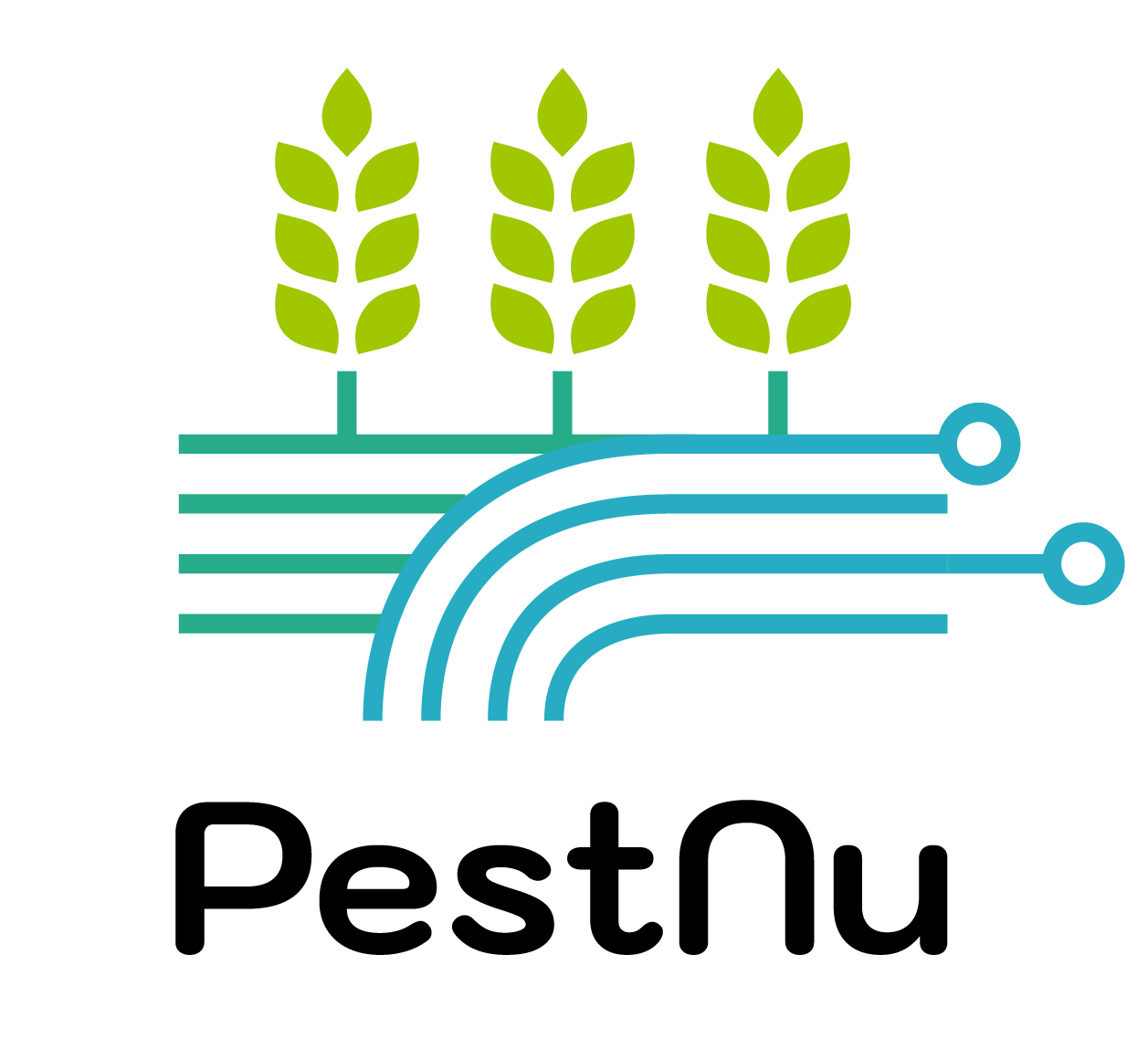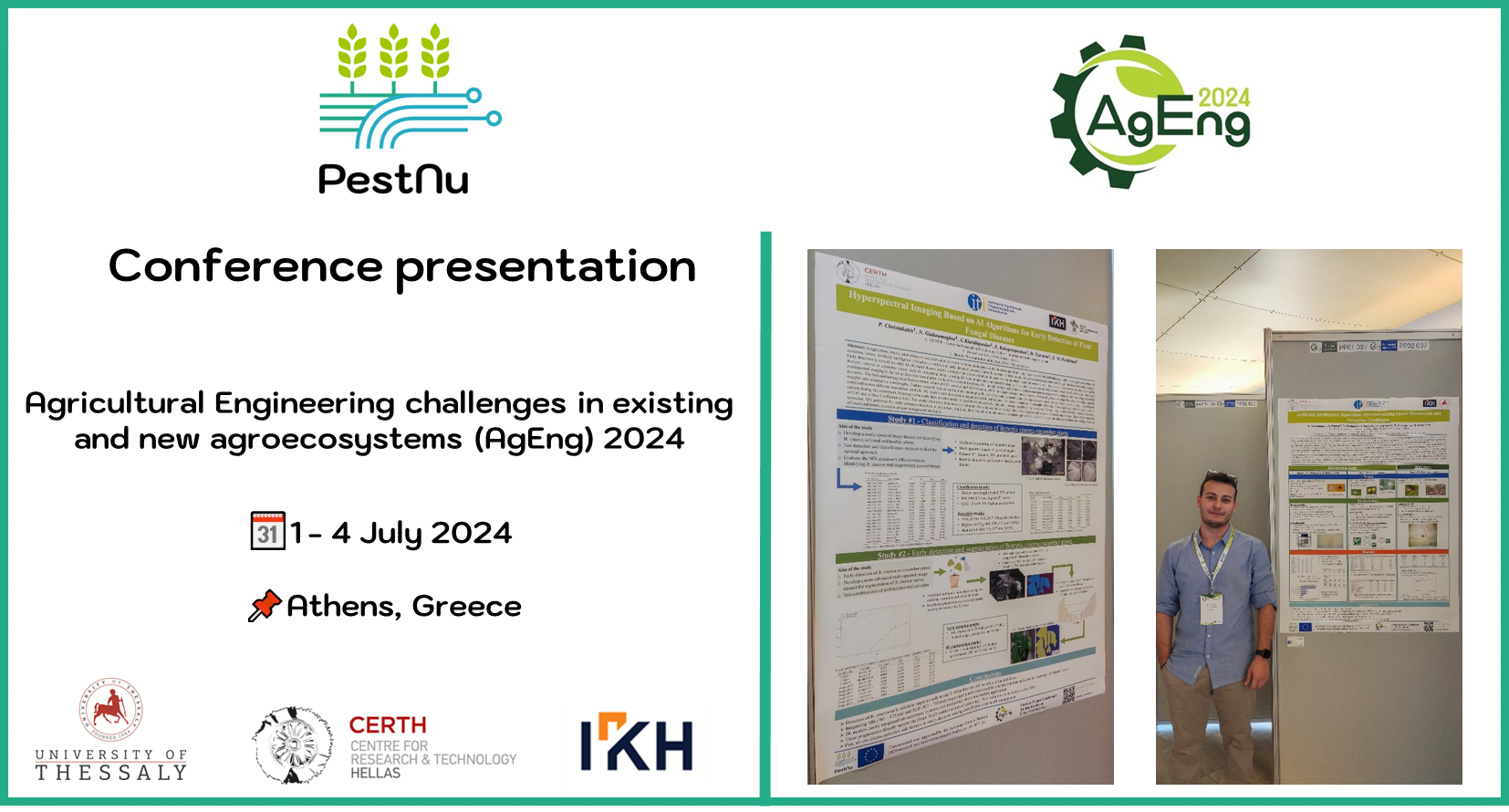PestNu partners, CERTH, University Of Thessaly and iKnowHow participate in the Agricultural Engineering challenges in existing and new agroecosystems (AgEng2024) conference at the Agricultural University of Athens, Greece!
Panagiotis Christakakis from Dr. Ria Pechlivani’s team CERTH-ITI demonstrated PestNu outcomes and, also, the team presented two scientific studies through posters at this event.
Study Titles:
- Hyperspectral Imaging Based on AI Algorithms for Early Detection of Plant Fungal Diseases.
- Artificial Intelligence Algorithms Revolutionizing Insect Monitoring and Detection Challenges.
“Hyperspectral Imaging Based on AI Algorithms for Early Detection of Plant Fungal Diseases”
The abstract and the keywords of are the following:
In agriculture, timely intervention of crop pathogens is crucial, as fungal pathogens worldwide cause significant crop losses worth $100-$200 billion annually. To mitigate such substantial economic losses, Artificial Intelligence (AI) plays a vital role in early detection process. Currently, potential infections are visually detected and confirmed through laborious laboratory analyses. Early detection is crucial not only for the rapid disease control strategies but also to minimize impacts on crop production and the environment. This study aims to detect grey mould caused by Botrytis cinerea on cucumber plants, early by integrating Deep Learning (DL) techniques and multispectral imaging. Cucumber leaves were artificially inoculated with B. cinerea and employing multispectral imaging in the initial days post-inoculation, a dataset was created for diverse DL models. Both classification and object detection techniques were employed, demonstrating remarkable accuracy. The best-performing classification model achieved 0.93 accuracy and 0.89 F1-score, while the object detection model reached 0.88 mAP50 (mean Average Precision), providing valuable insights into informative wavelengths. Further research focused on the more challenging DL task of semantic segmentation, creating a comprehensive dataset featuring healthy and infected plants subjected to two different inoculation methods. DL models were developed to segment specific leaf regions. The dataset contained photographs of the cucumber plants captured with a multispectral camera during the experiment, focusing on the early days, to test whether it is possible to detect early symptoms that are invisible to the naked eye. The resulting model exhibited impressive accuracy of 0.90 and a Dice Coefficient of 0.67. The model effectively detected early symptoms from the second to the sixth day, providing a crucial window for timely intervention. These implementations showcase AI’s potential for early pathogen detection in agriculture. Applying these models to autonomously navigated agro-robots and mobile apps can enhance real-time monitoring, enabling efficient and timely proactive disease management strategies.
Keywords: artificial intelligence, deep learning, hyperspectral imaging, early detection, smart agriculture
“Artificial Intelligence Algorithms Revolutionizing Insect Monitoring and Detection Challenges.”
The abstract and the keywords are the following:
Insect crop attacks present a significant challenge that Artificial Intelligence (AI) can help address. Early insect detection and insect population growth prediction can bolster yield in both open fields and greenhouse cultivations. Olive trees, vulnerable to the olive fruit fly, Bactrocera oleae (BO), and vegetables like tomatoes and cucumbers, often attacked by pests like Tuta absoluta, aphids, and whiteflies, underscore the significance of AI in agricultural applications. This study, aims to provide Deep Learning (DL) models for crop monitoring and early detection of these insects and their plant symptoms, aligning with the Green Deal 2030 principles of agricultural sustainability and reduced reliance on chemical pesticides. This study utilizes available RGB images from libraries in combination with synthetic datasets and datasets created with insect traps. In particular, four implementations were developed. a) For detecting infestations of Tuta absoluta, DL was combined with ensemble techniques, by merging outputs from multiple models, enhancing detection metrics by 20% and elevating the mAP50 (mean Average Precision) from 0.58 to 0.70. b) To overcome insufficient data of small insects (1 and 4 mm), adhesive traps were employed to capture images of prevalent insects in vegetable crops, including whiteflies and black aphids and the DL models reached 0.75 mAP50 for the detection of these miniscule insects. c) To tackle whiteflies data scarcity, a synthetic dataset was generated, reaching 0.66 mAP50, coupled with a high accuracy of 0.76. d) For the detection of BO, a threat to the olive industry, a DL technique for creating lightweight models was used, reaching 0.81 mAP50, enabling real-time detection in-situ. These high-performing results apply to a range of digital tools (mobile apps, argo-robots, AI-based robotic traps). Real-time monitoring, insect population growth prediction, and integration with Decision Support Systems is achieved, providing essential data for informed decision-making in crop protection while also enabling timely intervention.
Keywords: artificial intelligence, smart agriculture, deep learning, insect detection, smart farming

